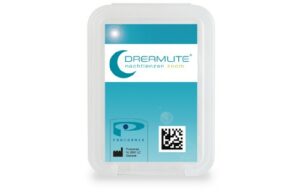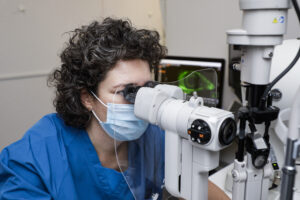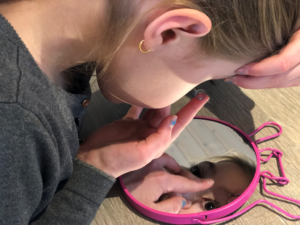YÖLINSSIT ZOOM


DREAMLITE ZOOM
- Vapauta itsesi lasista ja piilolinsseistä päivän aikana
- Turvallinen ja palautuva korjaus
- Ei-kirurginen vaihtoehto taitekirurgialle
Et usko silmiäsi! Kuinka helppoa se voi olla? Käytä piilolinssejäsi yöllä ja koe aamuisin selkeä ja mukava näkemys loppupäivän ajan ilman silmälaseja tai linssejä. Täydellinen vaihtoehto tavallisille piilolinssien käyttäjille, jotka kärsivät silmien punoituksesta ja kuivumisesta, sekä aktiivisen elämäntavan omaaville ihmisille.
Kuka voi käyttää Dreamlite Zoomia
DreamLite Zoom -objektiivit sopivat niille, jotka kärsivät likinäköisyydestä tai likinäköisyydestä ja joilla on samalla alkuvaiheessa lukemisvaikeuksia. DreamLite Zoom -piilolinssit voivat korjata pallomaisen voimakkuuden -0,75 D – -5,50 D.Lisäksi voidaan korjata rakennusvirhe, jonka maksimiarvo on -2,50 D, sekä multifokaalinen korjaus, joka on enintään +1,75 D. näkö koko päivän ajan mistä tahansa etäisyydestä.
Kuinka se toimii?
Kun olet likinäköinen, silmäsi ovat hieman liian pitkät. Silmään sarveiskalvon läpi tuleva valo kohdistuu verkkokalvon eteen, minkä jälkeen valo sirontaa. Tämä aiheuttaa etäisyyden näön hämärtymisen. DreamLite-piilolinssin erityinen muoto tasoittaa sarveiskalvon helposti käyttämällä tyhjiötä yön yli, mikä siirtää polttopisteen takaisin verkkokalvolle nukkuessasi.
Herätysaikana silmälaseja tai piilolinssejä ei tarvita. Prosessi on 100% palautuva: Kun lopetat DreamLite-laitteesi käytön, silmäsi saavat ’vanhan’ muodon muutamassa päivässä. Se on täydellinen ratkaisu ihmisille, joilla on aktiivinen elämäntapa, niille, jotka kärsivät säännöllisesti silmien punoituksesta ja kuivumisesta, ja hyvä ei-kirurginen ja turvallinen vaihtoehto näkökirurgialle, kuten LASIK.
Käyttää
DreamLite Zoom RGP -objektiivit on valmistettu erittäin happea läpäisevästä materiaalista. Niitä voidaan käyttää jopa vuoden ajan.
Lisää vaihtoehtoja
DreamLite-yölinssejä on saatavana pallomaisina, toorisin, multifokaalisin ja toricin multifokaalisinä versioina. Nämä mittatilaustyönä valmistetut RGP-linssit on suunniteltu yksilöllisesti sinun tulostesi perusteella optikko.
Lue käyttöohjeet huolellisesti ennen Dreamliten käyttöä. Tiedot antaa piilolinssi-asiantuntijasi. Haluatko lisätietoja tai neuvoja? Ota yhteyttä puhelimitse +45 75 10 24 10
Suosittelemme DreamLite-piilolinssien puhdistamista, desinfiointia, varastointia ja huuhtomista Ever Clean ja Unidose saline tai Regard K
DreamLite Zoom on ensimmäinen Alankomaissa tuotettu multifokaalinen orto-k / yö-objektiivi.
Yhä useampi piilolinssien käyttäjä, jolla on alkavia lukemisongelmia, tuo meille uusia haasteita. Monet näistä asiakkaista eivät saavuta optimaalista näkyvyyttä ja mukavuutta pehmeillä piilolinsseillä.
DreamLite Zoom on loistava ratkaisu presbyope-asiakkaille, koska multifokaalinen alue on aina keskitetty. Lisäksi asiakkaat kokevat hyvän kontrastin, mikä antaa selkeän kuvan. DreamLite Zoom on tervetullut lisä valikoimaasi ja tehokas ratkaisu näille asiakkaille.
Periaate
DreamLite Zoom on suunniteltu siten, että sarveiskalvoon luodaan multifokaalinen profiili yön aikana. Kun linssit otetaan pois aamulla, voidaan nähdä terävästi kaikilta etäisyyksiltä, ilman linssejä tai laseja. Se toimii keskietäisyyden linssinä sarveiskalvon reunan reunan kanssa. Vyöhykkeet eivät liiku välähdyksillä, kuten tavallisten piilolinssien kohdalla, tämä johtaa parempaan optiseen laatuun kuin tavallisissa piilolinsseissä
Mukavuus
Silmien kuivumisen aiheuttama vähentynyt mukavuus on tunnettu valitus pehmeiden piilolinssien käyttäjien keskuudessa. Mitä vanhemmaksi tulet, sitä suurempi tämä ongelma tulee. DreamLite Zoomia ei käytetä päivällä, joten se ei aiheuta kuivuusongelmia.
Järjestämme säännöllisiä online-objektiivikursseja, jos haluat tietää enemmän, ota meihin yhteyttä puhelimitse +45 75 10 24 10.
Mukauttaminen
Linssi lasketaan erityisessä sovitusohjelmassa nimeltä MyProcornea. Ohjelma on yhteensopiva kaikkien Pohjoismaissa vaihdettujen topografien kanssa. Ohjelma on ilmainen käyttää.
| Parametre Dreamlite: | ||
|---|---|---|
| Radius: | individuelt beregnet ved hjælp af topografidata | |
| Sfærisk styrke (F’v): | -0.75 til -5.50 D | |
| Cylindrisk refraktion: | Max. -2.50 D | |
| Diameter: | 10.00 mm / 10.50 mm / 10.90 mm / 11.30 mm | |
| Optisk zone: | 6.00 mm | |
| Multifokal korrektion: | Max. +1.50 D afhængig af afstand | |
| Teknisk information | ||
| Materiale: | Boston XO | |
| Applikation: | Hver nat | |
| Farve | Højre linse: Lilla Venstre linse: Blå | |
| Kan anvendes til normale regulære cornea | ||
| Forpakning: | Blister |
New Danish research project:
Night lenses significantly reduce myopia in nearsighted children
A study conducted at Vejle Hospital has shown that nearsighted children who sleep with night lenses develop 59 percent less myopia than children who wear glasses. The findings have led to the Department of Ophthalmology at the hospital offering night lenses as part of the treatment
By Steen Tue Bjerborg
The progression of myopia can be slowed in growing children, who can sleep their way to significantly better vision by wearing night lenses in bed. Such are the findings of a new Danish research project conducted at the Department of Ophthalmology at Vejle Hospital. And 13-year-old Frida Bille from Kolding, who participated in the study from start to finish, is today, happy and better-sighted living proof of that.
“For the three years that I have slept with night lenses, I haven’t worn glasses at all. And yet I feel that I can see better now and can see the details on the curbs when we drive past them,” Frida smiles after her final consultation at Vejle Hospital.
A total of 60 nearsighted children aged six to 12, referred by ophthalmologists from all over Jutland and Funen, took part in the random study. Thirty of the children wore glasses for a year and a half The other 30 children, like Frida, slept with night lenses without wearing glasses. And there is a marked and significant difference in eye development between the two groups.
59 percent less nearsightedness
The 30 children who slept with night lenses but did not wear glasses had far smaller axial length development – and thus progression of myopia – than the children who wore glasses but did not sleep with night lenses.
The study therefore concludes that night lenses can slow down the progression of myopia in growing children by 59 percent. And without sight-threatening complications and conditions requiring treatment, too. The risk of children developing high myopia and serious eye diseases such as glaucoma, retinal detachment and retinal changes later in life is thus also greatly reduced.
“It’s a fantastic result – so good, in fact, that we’ve now decided to offer the night lenses as part of the treatment of children at the Department of Ophthalmology. So far, six children with myopia have agreed to the treatment, which has now started,” explains Trine Møldrup Jakobsen, doctor and clinical research assistant at the Department of Ophthalmology, who led the study at Vejle Hospital as part of her ophthalmology doctorate.
Danish proof needed
Flemming Møller, Consultant at the Department of Ophthalmology at Vejle Hospital, suggested that Trine Møldrup Jakobsen conduct her research into night lenses. He explains that previous research in Asia and Southern Europe has, in fact, already demonstrated that night lenses can slow the progression of myopia in children, but it has never been studied and proven in Denmark and Scandinavia. This was necessary for the findings to be applied to Danish children.
“On the one hand, there are major genetic differences between Asian children and Northern European children. On the other, there have been great cultural differences in the way children in Asia and Northern Europe have lived and strained their eyes, particularly in the past. That is why we were unable to apply the findings from Asian children to Danish and Scandinavian children – hence the need to investigate it ourselves,” states Møller.
The incidence of myopia in children in Asia has in some areas been as high as 90 percent. However, like other Danish ophthalmologists, Flemming Møller has also seen a clear increase in myopia in Danish children in recent years. This is confirmed by a recent study which showed that the incidence of myopia in children in Denmark has increased from 13 percent in 2007 to 25 percent today.
Flemming Møller therefore proposed that Trine Møldrup Jakobsen conduct her ophthalmology doctorate as a research project on the effect of night lenses on the progression of myopia in children. The ophthalmologist was first made aware of the effect by his night lens supplier, Esben Sørensen of Ens Eyes, a company from Kolding, Denmark, which distributes night lenses to opticians and ophthalmologists all over Scandinavia.
“We’ve been in business for a good ten years. And we’ve been pushing all this time for a study into and recognition of the ability of night lenses to slow down the progression of myopia in Scandinavian and Danish children. So, it’s fantastic that we finally have Danish research findings that prove how night lenses can counteract myopia in children,” says Sørensen.
Will continue with night lenses
Trine Møldrup Jakobsen has now had her research study approved as a PhD thesis, and the Department of Ophthalmology at Vejle Hospital has started using the night lenses in the treatment of children with myopia. However, this does not mean that the new ophthalmologist will be stopping her research into night lenses.
“We’re embarking on a follow-up study over several years because we want to follow the development and see the results over a longer period. But that does not alter the fact that we have now proven that night lenses can actually slow the progression of myopia in children,” she affirms.
And Frida Bille is in no doubt at all. She will continue to sleep with night lenses even though her part in the study is now over.
“It’s so cool when I go to school and do PE. I can just take the night lenses out in the morning and don’t have to wear glasses and contact lenses for the rest of the day,” says the nearsighted girl, who has worn the lenses pretty much from the outset, even though she was only nine at the time.
“Dad wasn’t that good at putting them in, so I just did it myself and have done ever since. And it’s no problem at all,” laughs Frida, who is, however, sad about one thing:
“It’s a shame for Mum, because she’s really nearsighted and should have had the chance to sleep with night lenses like me when she was young. But she was the one who suggested that I take part in the study, and now she’s just so happy for me.”
Facts
A night lens is a dimensionally stable lens which, by means of its vacuum effect, combined with the eyelid being closed, can prevent the eye from growing in length and thus slow the progression of myopia.
The risk of developing glaucoma, retinal detachment and retinal changes is greater in people with high myopia (above -5).
The research project in Vejle involved the participation of 60 children from Jutland and Funen, randomly divided into two groups, with one group sleeping with night lenses and the other without.
The findings of the research project have shown that night lenses can slow the progression of myopia in growing children by 59 percent – without sight-threatening complications or conditions requiring treatment.
The night lenses used in the study were supplied by Ens Eyes in Kolding. The company has been following worldwide research conducted into night lenses for ten years and supplies night lenses to opticians and ophthalmologists all over Scandinavia and in Iceland.










